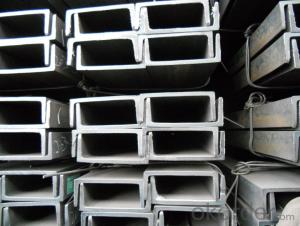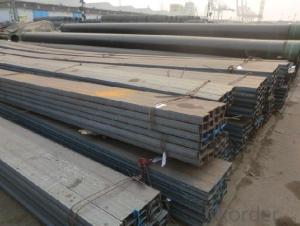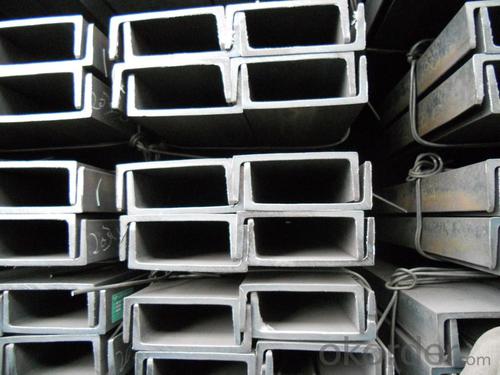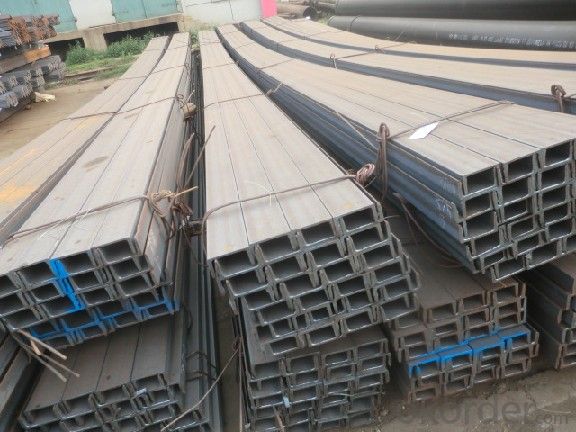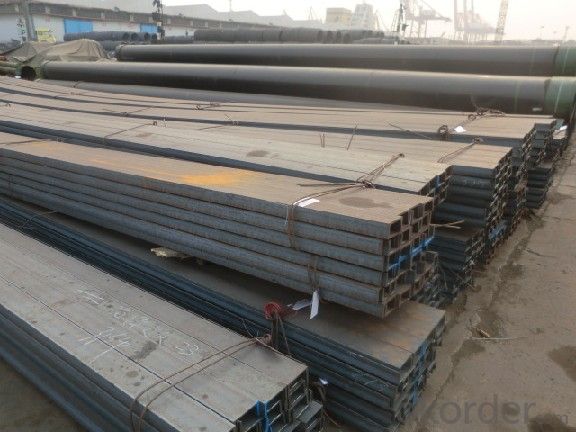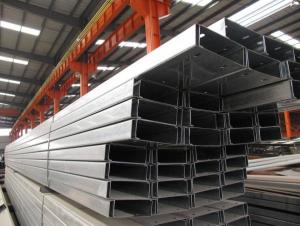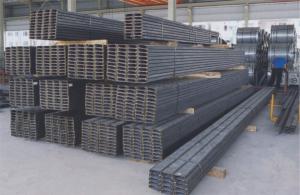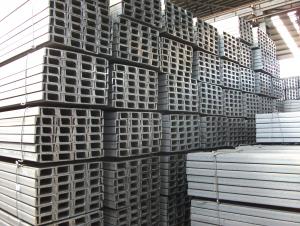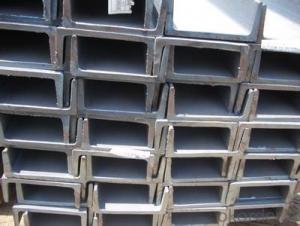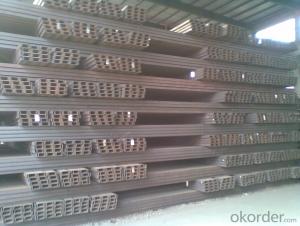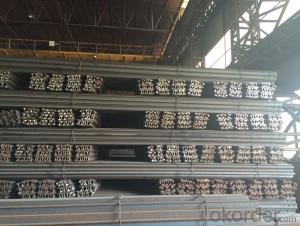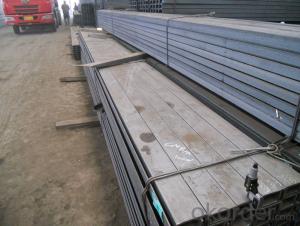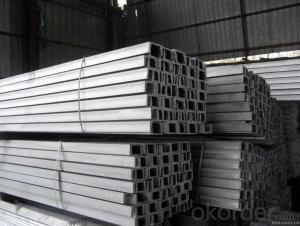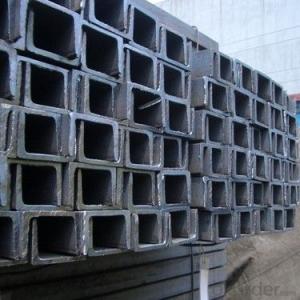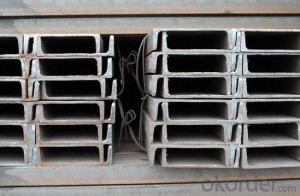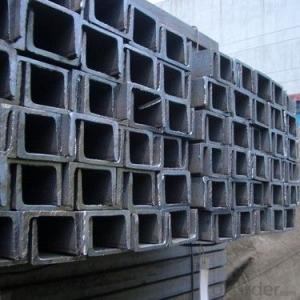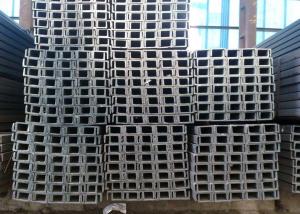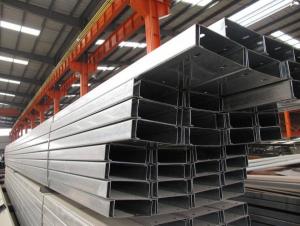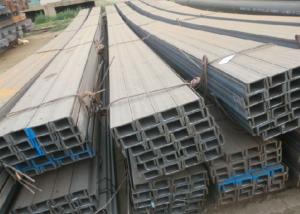JIS SS400 Steel Channel with High Quality 150mm
- Loading Port:
- Tianjin
- Payment Terms:
- TT OR LC
- Min Order Qty:
- 25 m.t
- Supply Capability:
- 10000 m.t/month
OKorder Service Pledge
OKorder Financial Service
You Might Also Like
JIS SS400 Steel Channel with High Quality 150mm
Product Description:
Standard: JIS
Material: SS400
Length: 6m, 12m
Size:
Size (mm) | Mass (Kg/m) |
150*75*5.5 | 14.66 |
150*75*6.0 | 17.90 |
150*75*6.5 | 18.60 |
Package & Delivery of JIS SS400 Steel Channel with High Quality 150mm:
1.The hot rolled channel steel will be packed in bundle with steel wire at each end of every bundle and color marking in order to help the customer to recognize his goods more easily at sight.
2. And the hot rolled channel steel could be loaded into 20ft or 40ft container, or by bulk cargo.If the weight of each bundle reaches more than 3.5 mt, the loading by break bulk cargo should be choosed.When the weight of each bundle reaches less than 3mt, the loading by container should be choosed.
3.As for the transportaion from mill to loading port, the truck will be usually used. And the maximum quantity for each truck is 40mt.
4.All in all, we could do in accordance with customer's request.
Production Flow of JIS SS400 Steel Channel with High Quality 150mm:
1.The steel billet shall be heated in the high temperature furnace.
2. The heated steel billet shall be rolled five to nine times with the aim of shaping the general figure of steel u channel.
3. The rolled steel channel should be put onto the cooling bed to make the temperature low.
4. The JIS Channel should be straighted on the straightener.
5. The straighted steel u channel will be cut into meters by saw, as per customer's requirements.
6. At the last part of production, the channel steel must be tested in order to confirm that the finished products are completely free from crack, pore, slag, scab or fold on the surface.
FAQ:
Q1: Why buy Materials & Equipment from OKorder.com?
A1: All products offered byOKorder.com are carefully selected from China's most reliable manufacturing enterprises. Through its ISO certifications, OKorder.com adheres to the highest standards and a commitment to supply chain safety and customer satisfaction.
Q2: How do we guarantee the quality of our products?
A2: We have established an advanced quality management system which conducts strict quality tests at every step, from raw materials to the final product. At the same time, we provide extensive follow-up service assurances as required.
Q3: How soon can we receive the product after purchase?
A3: Within three days of placing an order, we will arrange production. The shipping date is dependent upon the quatity, how many sizes you want and the plan of production, but is typically 1 month to 2 month days from the beginning of production.
Images of JIS SS400 Steel Channel with High Quality 150mm:
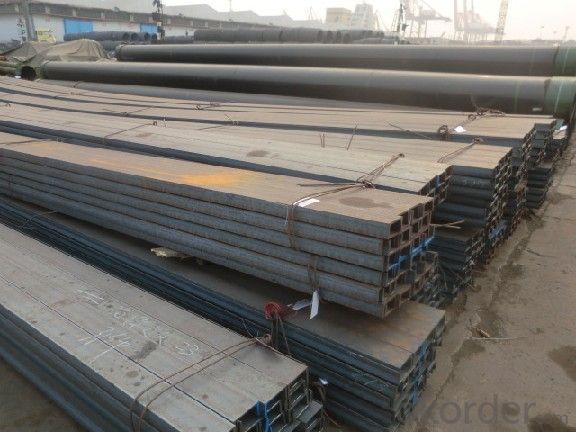

*If you would like to get our price, please inform us the size, standard/material and quantity. Thank you very much for your attention.
- Q: Can steel channels be used for supporting signage and billboards?
- Yes, steel channels can be used for supporting signage and billboards. Steel channels are known for their strength and durability, making them suitable for providing structural support to hold and secure various types of signage and billboards.
- Q: Are steel channels suitable for modular furniture?
- Yes, steel channels are suitable for modular furniture. Steel channels are strong and durable, making them an ideal material for furniture that needs to withstand heavy weight and frequent use. They provide stability and support, making them suitable for various modular furniture designs such as shelving units, desks, and cabinets. Additionally, steel channels can be easily customized and cut to specific lengths, allowing for flexible and modular designs. They also offer a sleek and modern aesthetic, making them a popular choice for contemporary furniture styles. Overall, steel channels are a reliable and versatile material for modular furniture, providing both functionality and aesthetics.
- Q: I unit of a shopping center construction project, 4.2 meters high, four floors.Because the first floor is adjacent to the building, the scaffold can not be erectedWe would like to use 20 channel three from 2 to 15 meters, ask how much channel spacing?
- You set the bar spacing 1.5 meters, step distance 1.8, the general parameters know the spacing of the channel.
- Q: What is the maximum length of steel channels?
- The length of steel channels can differ based on different factors, including the manufacturer's specifications, transportation restrictions, and practical considerations of handling and installation. Typically, standard lengths for steel channels range from 20 to 40 feet (6 to 12 meters). These lengths are commonly established by the manufacturing process and the equipment's capabilities for cutting and forming the channels. To ascertain the precise maximum length for a specific type of steel channel, it is essential to consult with the manufacturer or supplier.
- Q: Can steel channels be used in curved designs?
- Yes, steel channels can be used in curved designs. Steel channels are versatile structural elements that can be shaped to fit various curves and contours. They can be bent or curved using specialized machinery and techniques such as hot bending or cold bending. This allows for the creation of custom curved designs using steel channels. The curved steel channels provide strength, stability, and durability to the structure while adding an aesthetic appeal to the overall design.
- Q: What are the different surface finish options for steel channels?
- Steel channels offer a variety of surface finish options, each with its own unique properties and visual appeal. Some common finishes for steel channels include: 1. Hot-dip galvanized: Immersing the steel channel in molten zinc creates a protective coating that prevents corrosion. This finish provides excellent durability and a matte gray appearance. 2. Powder coating: This popular option allows for a wide range of colors and textures. Dry powder is applied to the channel's surface and then baked to create a smooth and durable finish. 3. Painted: Customization in color and finish is possible through painting. Typically, the channels are primed before applying solvent-based or water-based paint, providing good rust protection and aesthetic appeal. 4. Stainless steel: An untreated stainless steel finish offers excellent corrosion resistance and a modern look. This finish is commonly used in industries where cleanliness is important, such as food and beverage. 5. Anodized: Though typically used for aluminum, anodizing can also be applied to steel channels. This process creates a layer of oxide on the surface, enhancing corrosion resistance and providing a decorative finish. Anodized steel channels are available in various colors. 6. Electropolishing: By immersing the steel channel in an electrolyte bath and passing an electric current through it, a thin layer of metal is removed, resulting in a smooth and shiny surface. Electropolishing improves corrosion resistance and finds applications in industries where cleanliness and aesthetics matter, such as pharmaceutical and medical. The choice of surface finish for steel channels depends on specific application requirements, desired aesthetics, and the necessary level of corrosion resistance. Factors such as durability, maintenance, and cost should be considered when selecting the appropriate finish.
- Q: Can steel channels be used in the construction of solar panel mounting structures?
- Yes, steel channels can be used in the construction of solar panel mounting structures. Steel channels provide strong support and stability, making them suitable for holding the weight of solar panels and withstanding various environmental conditions.
- Q: Can steel channels be used in the renewable energy manufacturing industry?
- Yes, steel channels can be used in the renewable energy manufacturing industry. Steel channels are versatile structural components that have a wide range of applications across various industries, including renewable energy. In the manufacturing of renewable energy equipment such as wind turbines, solar panels, and hydroelectric systems, steel channels can be utilized for various purposes. One of the primary uses of steel channels in the renewable energy manufacturing industry is for the construction of support structures. Wind turbines, for example, require sturdy support structures to withstand the forces exerted by wind. Steel channels provide the necessary strength and rigidity to support the weight of the turbine and its rotating blades. Similarly, in the manufacturing of solar panels, steel channels are often used to create the framework that holds the photovoltaic cells in place. These channels provide a stable and durable structure that can withstand various weather conditions and ensure the longevity of the solar panels. Furthermore, steel channels can also be employed in the manufacturing of hydroelectric systems. These systems involve the construction of dams, penstocks, and other water control structures. Steel channels are commonly used to build the frames and supports for these structures, ensuring their stability and durability. Apart from support structures, steel channels can also be utilized in the renewable energy manufacturing industry for cable management and electrical wiring. They can be used to create cable trays or conduit systems that organize and protect the electrical cables in wind turbines, solar farms, or other renewable energy installations. In summary, steel channels are indeed suitable for use in the renewable energy manufacturing industry. Their strength, versatility, and durability make them an excellent choice for support structures, framework construction, cable management, and various other applications.
- Q: Can steel channels be used for solar panel installations?
- Yes, steel channels can be used for solar panel installations. Steel channels provide a strong and durable framework for mounting and securing solar panels, ensuring stability and longevity of the installation.
- Q: How are steel channels installed in construction projects?
- Steel channels are typically installed in construction projects by first determining the precise location and orientation required. Then, the channels are positioned and anchored securely using bolts, welds, or other fastening methods. This ensures stability and structural integrity, allowing the channels to support loads and provide necessary reinforcement.
Send your message to us
JIS SS400 Steel Channel with High Quality 150mm
- Loading Port:
- Tianjin
- Payment Terms:
- TT OR LC
- Min Order Qty:
- 25 m.t
- Supply Capability:
- 10000 m.t/month
OKorder Service Pledge
OKorder Financial Service
Similar products
Hot products
Hot Searches
Related keywords
